- Home
- Edgar Allan Poe
The Science Fiction of Edgar Allan Poe (Penguin Classics) Page 44
The Science Fiction of Edgar Allan Poe (Penguin Classics) Read online
Page 44
Letter II, May 1844, Doings of Gotham (1929), p. 34
The first transatlantic balloon voyage, exactly a century later, recorded almost the same number of hours and many of the incidents in Mr Monck Mason’s log.
1. (p.110) Mr Monck Mason’s FLYING MACHINE!!!! : Monck Mason exhibited his motor-driven dirigible balloon at the Royal Adelaide Gallery, London, in 1843. It made repeated flights around the large hall at the rate of six miles an hour.
2. (p. 110) Arrival at Sullivan’s Island: The setting of Poe’s prizewinning ‘The Gold-Bug’, published the previous year (1843). As Private Edgar A. Perry of Battery H of the First United States Artillery, he had served for more than a year as regimental clerk at Fort Moultrie, overlooking Sullivan’s Island (1827–8).
3. (p. 111) By the energy of an agent at Charleston, S.C.: T. O. Mabbott discovered that in February 1844 the brig Moon had made the run from New York to Savannah so fast that it beat the U.S. mails by three days. That recent headline is invoked to confirm the Sun’s latest and even more extraordinary coup (Letter to the New York Sun, 23 January 1943). There was no telegraph, of course, to check such news stories. Samuel Morse had been working on the idea of an electric telegraph since 1832, but it was only in this year, 1844, that he demonstrated to Congress its practicality by transmitting messages, by code, over a wire from Washington to Baltimore. Soon after, the nomination of James K. Polk as Democratic candidate was telegraphed to Washington.
4. (p. 111) Mr Harrison Ainsworth, author of ‘Jack Sheppard’, &c: The historical novelist, at this time editor of Ainsworth’s Magazine, and established best-seller: Jack Sheppard (1839), The Tower of London (1840), Windsor Castle (1843) etc.
Poe was scornful. His review of The Tower of London opens: ‘The authorship of this work does a little, and but a little, more credit to Mr Ainsworth than that of “Jack Sheppard”. It is in no spirit of cavilling that we say that it is rarely our lot to review a work more utterly destitute of every ingredient requisite to a good romance.’ And concludes: ‘Such libels on humanity, such provocatives to crime, such worthless, inane, disgraceful romances as “Jack Sheppard” and its successors, are a blot on our literature and a curse to our land.’ (Graham’s Magazine, March 1841). He returned to the charge, with a review of Guy Fawkes; or the Gunpowder Treason in the November issue.
For ‘The Balloon-Hoax’ is also a literary burlesque. Harrison Ainsworth, in propria persona, is made to parody his own melodramatic prose:
The waters give up no voice to the heavens. The immense flaming ocean writhes and is tortured uncomplainingly. The mountainous surges suggest the idea of innumerable dumb gigantic fiends struggling in impotent agony.
p. 120
Yet who but Ainsworth – romantic visionary on high – contributes that bold, creative stroke: of making a bid for North America?
5. (p. 111) Mr Henson, the projector of the late unsuccessful flying machine: William Samuel Henson, designer of the ‘aerial steam carriage’ – a monoplane, driven by a 25 horse-power steam-engine that never left the ground. As early as 1842 he lobbied Parliament for support of his newly formed Aerial Steam Transportation Company.
The Glasgow Constitutional, like Poe, saw scope for a hoax, publishing an account of an experimental flight over the Clyde that ended with a crash into the river (April 1843). The London Times, for one, was hoodwinked and reprinted the story. Apart from Mason, Henson, Robert Hollond M.P., and Ainsworth, the rest of the cast (titles and all) are fictitious.
6. (p. 112) from Dover to Weilburg in the balloon, ‘Nassau’: Indicating Poe’s key source. Over a quarter of his text is appropriated from two pamphlets by Thomas Monck Mason: Account of the Late Aeronautical Expedition from London to Weilburg, Accompanied by Robert Hollond, Esq., Monck Mason, Esq., and Charles Green, Aeronaut (London, 1836; New York, 1837) and Remarks on the Ellipsoidal Balloon, Propelled by the Archimedean Screw, Described as the New Aerial Machine (London, 1843).
At 1.30 p.m. on 7 November 1836 Mason, Hollond and Green had ascended in an 82,000 cubic-foot balloon from Vauxhall Gardens, London, to descend at 7.30 a.m., next day, near Weilburg in the Duchy of Nassau – a journey of approximately 500 miles in 18 hours.
The flight broke all records and created a sensation. The Remarks on the Ellipsoidal Balloon was published for Mason’s exhibit at the Royal Adelaide Gallery.
7. (p. 112) the failure of Mr Henson’s scheme, and of Sir George Cayley’s: Both the description of ‘Mr Henson’s scheme’ and of Sir George Cayley’s exhibit at the Polytechnic Institution derive, almost verbatim, from Remarks on the Ellipsoidal Balloon. As early as 1809 Sir George Cayley had proposed a theory of flight for fixed-wing model aircraft. He experimented unsuccessfully with a hybrid helicopter-cum-aeroplane : two manually operated windmills being provided for take-off, a small propeller for forward thrust.
8. (p. 112) his own was an ellipsoid… in the opposite direction: The next two paragraphs, with all their technicalities, too derive from Mason. In every detail – including the illustration on the broadside extra – Poe’s ‘Victoria’ is modelled on Mason’s model.
9. (p. 113) oiled silk cut into gores: Triangular wedges.
10. (p. 113) shaped somewhat like a battledoor: Commonly ‘battledore’, the racket used in playing with a shuttlecock.
11. (p. 114) we are indebted to Mr Charles Green: cf. an editorial (clearly by Poe) in Burton’s Gentleman’s Magazine:
Pure hydrogen must be discarded, as too subtle for our present means of retention. Balloons inflated with carburetted hydrogen (common coal gas) will retain a good inflation for a great length of time. Mr G. states that he has had gas of this kind brought in small balloons, to fill his large one, from a distance of five or six miles; and we observe (what Mr G. has not) that in Vienna, according to a simple method invented by M. F. Derionet, the gas is conveyed in hermetically sealed bags… from the factory to all parts of the town daily.
(March, 1840)
12. (p. 115) for warming coffee by means of slacklime: Lime disintegrating under moisture. Poe’s neologism was coined from Mason’s explanatory footnote: ‘… without the intervention of fire, by the means of slacked lime’ (Account, p. 11).
13. (p. 115) Mr Green’s invention of the guide-rope: cf. Mason:
By the simple contrivance of a rope of the requisite magnitude and extent, trailing on the ground beneath, (and if over the sea, with a sufficient quantity of liquid ballast contained in vessels floating on its surface,) have all these difficulties… been overcome.
Account, pp. 8–10
It was this gadget, Mason reckoned, that opened up the way to an ocean crossing:
Under the sway of such an instrument, the ocean, no longer the dreaded enemy of the aerial voyager, becomes at once his greatest friend… In his view, the Atlantic is no more than a simple canal; three days might suffice to effect its passage.
Aeronautica, or Sketches Illustrative of the Theory and Practice of Aerostation (1838)
14. (p. 117) Wheal-Vor House… about a mile from Penstruthal: This four-wheel house or caravan, that Poe swears is his ‘pen’s truth all’ – was a supernumerary little joke inside the hoax.
15. (p. 118) We now resolved to let off enough gas: Repeating Monck Mason’s manoeuvre, successful over the English Channel in 1836, over the Bristol Channel in 1844!
16. (p. 118) a strong current of wind from the East: But now a misadventure, overcome on the flight to Weilburg, becomes the pretext for continuing this mock-adventure to North America.
17. (p. 121) an elevation equal to that of Cotopaxi: cf. ‘at 18,000, which is not far from the elevation of Cotopaxi…’ (‘Hans Pfaal’, p. 348, note 18).
18. (p. 121) absolutely and most unequivocally concave: cf. ‘What mainly astonished me, in the appearance of things below, was the seeming concavity of the surface of the globe…’ (‘Hans Pfaall’, p. 348, note 25). The explanatory Note derives verbatim from the earlier story.
19. (p. 123) The grapnel caught at 2, P
. M., precisely: By Greenwich Mean Time, it appears, not Eastern Standard Time. Mr Forsyth (foresight?), the agent who completes the British log, overlooked the local Charleston clock. In all likelihood he missed the point in his ‘hurried account’, not having personally witnessed the landing. Or else he rightly assumed Mr Ainsworth’s ‘particulars’ to be consistent.
‘As for internal evidence of falsehood,’ Poe boasted, ‘there is, positively, none’ (May 1844).
Select Bibliography
WALTER B. NORRIS, ‘Poe’s Balloon Hoax’, The Nation vol. 91 (1910), pp. 389–90
HAROLD SCUDDER, ‘Poe’s “Balloon Hoax” ’, American Literature vol. 21 (1949), pp. 179–90
W. K. WIMSATT, JR, ‘A Further Note on Poe’s “Balloon Hoax” ’, American Literature vol. 22 (1951), pp. 491–2
RONALD WILKINSON, ‘Poe’s “Balloon Hoax” Once More’, American Literature vol. 32 (1960), pp. 313–17
T. N. WEISSBUCH, ‘Edgar Allan Poe: Hoaxer in the American Tradition’, New-York Historical Society Quarterly vol. 45 (1961), pp. 291–309
MESMERIC REVELATION
First Published
Columbian Lady’s and Gentleman’s Magazine (August 1844)
Reprinted
New World (3 August 1844)
Saturday Museum (31 August 1844)
Tales (1845), with long insertions
Universalist Watchman (August–September 1845)
American Phrenological Journal (September 1845). Billed as ‘authentic’, the article was repudiated in the October issue
Star of Bethlehem (4 October 1845)
Popular Record of Modern Science, no. 35 (London: 29 November 1845), as ‘The Last Conversation of a Somnambule’
Translated
Baudelaire, ‘Révélation magnétique’, La Liberté de penser (July 1848) : chosen for his first published translation
Anticipating the hypnotic techniques of Charcot and the subsequent development of Freud’s clinical methods, this dialogue is staged, as it were, on a psychoanalyst’s couch. Vankirk’s is to be the new church of mesmeric philosophy. Poe’s special fascination, as always, is in this state of suspended animation (or death-in-life) which was also a kind of life-in-death or living inhumation. Their apocalyptic progress and transformation he had long ago charted in The Narrative of Arthur Gordon Pym; their morbid conflation was soon to be the theme of ‘The Facts in the Case of M. Valdemar’.
For Poe himself was not a spiritualist. In 1845 he was to attend a series of lectures by the nineteen-year-old Andrew Jackson Davis in New York. Flanked by his own hypnotist and reporter, Davis dictated in an apparent state of trance. From the verbatim copy, he then compiled his Principles of Nature, Her Divine Revelations, and A Voice to Mankind (1847), a conflation of sermon with science fiction, mysticism and occult history, claiming verbal inspiration from unseen spirits. Though Davis was later to make several respectful allusions to Poe (in The Magic Staff and Events in the Life of a Seer), Poe’s reaction to Davis was invariably one of contempt – from his Marginalia to the mock-introduction of ‘my friend Martin Van Buren Mavis, (sometimes called the “Poughkeepsie Seer”,)’ prefixed to ‘Mellonta Tauta’.
As he wrote to James Russell Lowell:
I have no belief in spirituality. I think the word a mere word. No one has really a conception of spirit. We cannot imagine what is not. We deceive ourselves by the idea of infinitely rarefied matter. Matter escapes the senses by degrees – a stone – a metal – a liquid – the atmosphere – a gas – the luminiferous ether. Beyond this there are other modifications more rare. But to all we attach the notion of a constitution of particles – atomic composition. For this reason only, we think spirit different; for spirit, we say is unparticled, and therefore is not matter. But it is clear that if we proceed sufficiently far in our ideas of rarefaction, we shall arrive at a point where the particles coalesce; for, although the particles be infinite, the infinity of littleness in the spaces between them, is an absurdity. – The unparticled matter, permeating & impelling, all things, is God. Its activity is the thought of God – which creates. Man, and other thinking beings, are individualizations of the unparticled matter. Man exists as a ‘person’, by being clothed with matter (the particled matter) which individualizes him. Thus habited, his life is rudimental. What we call ‘death’ is the painful metamorphosis. The stars are the habitations of rudimental beings. But for the necessity of the rudimental life, there would have been no worlds. At death, the worm is the butterfly – still material, but of a matter unrecognized by our organs – recognized, occasionally, perhaps, by the sleep-waker, directly – without organs – through the mesmeric medium. Thus a sleep-waker may see ghosts. Divested of the rudimental covering, the being inhabits space – what we suppose to be the immaterial universe – passing every where, and acting all things, by mere volition – cognizant of all secrets but that of the nature of God’s volition – the motion, or activity, of the unparticled matter.
New York: 2 July 1844
Poe was doubtful what exactly to call this prelude to Eureka. In a letter to Professor Bush (author of Anastasis; or, The Doctrine of the Resurrection of the Body, Rationally and Scripturally Considered, 1844) he called it an ‘article’:
You will, of course, understand that the article is purely a fiction; – but I have embodied in it some thoughts which are original with myself & I am exceedingly anxious to learn if they have claim to absolute originality, and also how far they will strike you as well based.
New York: 4 January 1845
To Rufus Griswold he called it an ‘Essay’, insisting it be included in his projected anthology, Prose Writers of America (1847), ‘even if something else is omitted’ (24 February 1845). Griswold in the event published only ‘The Fall of the House of Usher’. As always Poe wanted to have it both ways. Six months later he was crowing:
the Swedenborgians inform me that they have discovered all that I said in a magazine article, entitled ‘Mesmeric Revelation’, to be absolutely true, although at first they were very strongly inclined to doubt my veracity – a thing which, in that particular instance, I never dreamed of not doubting myself. The story is a pure fiction from beginning to end.
‘Marginalia’, Godey’s Lady’s Book (August 1845)
1. (p. 124) the rationale of mesmerism, its startling facts: All point, as Sidney E. Lind argued, to Poe’s indebtedness to the Rev. Chauncey Hare Townshend’s Facts in Mesmerism (London, 1840). Townshend too had opened with ‘the fatal word Imposture’ and ‘Ridicule, which is not the test of truth’. He too ‘perceived that important deductions might be drawn from’ such facts; ‘and that they bore upon disputed questions of the highest interest to man, connected with the three great mysteries of being – life, death, and immortality’ (p. 51).
2. (p. 124) a colloquy, occurring between a sleep-waker and myself: Attacking the London Popular Record of Modern Science for piracy, Poe added:
It had the impudence, also, to spoil the title by improving it to ‘The Last Conversation of a Somnambule’ – a phrase that is nothing at all to the purpose, since the person who ‘converses’ is not a Somnambule. He is a sleep-waker – not a sleep-walker; but I presume that ‘The Record’ thought it was only the difference of an l.
‘Marginalia’, Graham’s Lady’s and Gentleman’s Magazine, Vol. 32
(March 1848)
Poe himself had learnt the distinction, it seems, from Townshend who used ‘Mesmeric Sleepwaking for Induced Somnambulism’ throughout his volume, ‘on the ground that Somnambulism, strictly speaking, was not always, nor necessarily, an adjunct of the condition I wished to describe’ (p. 10).
That condition we might call ‘deep hypnosis’ or ‘trance’.
3. (p. 125) advised to study Cousin: No doubt his electic Cours de l’histoire de la philosophie (in 8 volumes, 1815–29). Since 1840 ‘ministre de l’instruction publique’, Victor Cousin was at this time the supreme arbiter of educational and philosophical matters in France.
; 4. (p. 125) The ‘Charles Elwood’ of Mr Brownson : viz. Charles Elwood; or, The Infidel Converted (1840). Ex-Presbyterian, ex-Unitarian, ex-Transcendental editor of the Boston Quarterly Review, Orestes Augustus Brownson had entered the Roman Catholic Church in 1844.
5. (p. 125) His end had plainly forgotten his beginning, like the government of Trinculo: Like Gonzago’s rather, in Antonio’s scornful phrase: ‘The latter end of his commonwealth forgets the beginning’ (The Tempest, II, i, 154).
6. (p. 128) The truth is, it is impossible to conceive spirit: cf. Poe’s letter to James Russell Lowell: ‘No one has really a conception of spirit. We cannot imagine what is not’ (2 July 1844). Or as he paraphrased his argument a week later, writing to Dr Thomas H. Chivers:
There is no such thing as spirituality. God is material. All things are material; yet the matter of God has all the qualities which we attribute to spirit: thus the difference is scarcely more than of words. There is a matter without particles – of no atomic composition: this is God. It permeates and impels all things, and thus is all things in itself. Its agitation is the thought of God, and creates. Man and other beings (inhabitants of stars) are portions of this unparticled matter, individualized by being incorporated in the ordinary or particled matter. Thus they exist rudimentally. Death is the painful metamorphosis.
(10 July 1844)
Thus the quarrel with New England’s Transcendentalists, it turns out, hinges on a verbal quibble!
7. (p. 129) There seems to me an insurmountable objection: This whole scholastic debate for and against the ‘absolute coalescence’ of ether – P’s intervention and Vankirk’s reply – was inserted by Poe after first publication.

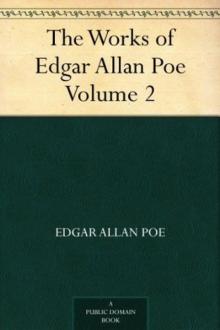 The Works of Edgar Allan Poe — Volume 2
The Works of Edgar Allan Poe — Volume 2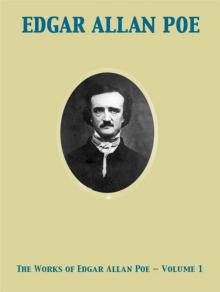 The Works of Edgar Allan Poe — Volume 1
The Works of Edgar Allan Poe — Volume 1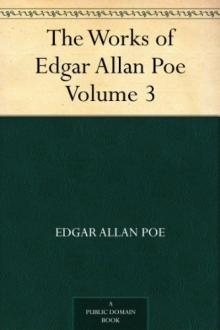 The Works of Edgar Allan Poe — Volume 3
The Works of Edgar Allan Poe — Volume 3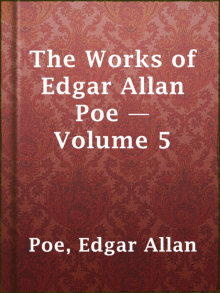 The Works of Edgar Allan Poe — Volume 5
The Works of Edgar Allan Poe — Volume 5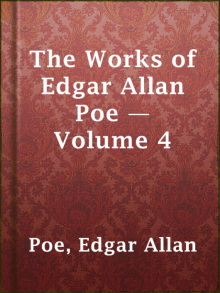 The Works of Edgar Allan Poe — Volume 4
The Works of Edgar Allan Poe — Volume 4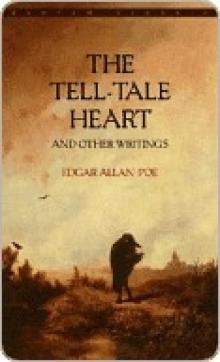 The Tell-Tale Heart
The Tell-Tale Heart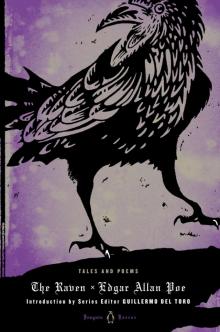 The Raven (Penguin)
The Raven (Penguin)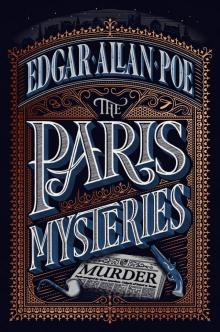 The Paris Mysteries
The Paris Mysteries Tales of Terror from Edgar Allan Poe
Tales of Terror from Edgar Allan Poe The Fall of the House of Usher
The Fall of the House of Usher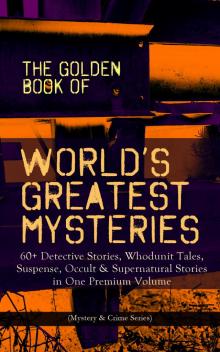 The Golden Book of World's Greatest Mysteries
The Golden Book of World's Greatest Mysteries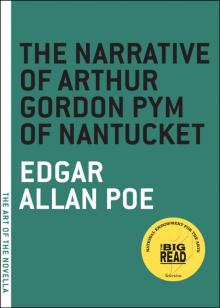 The Narrative of Arthur Gordon Pym of Nantucket
The Narrative of Arthur Gordon Pym of Nantucket Ligeia
Ligeia The Landscape Garden
The Landscape Garden Complete Tales & Poems
Complete Tales & Poems Great Tales and Poems of Edgar Allan Poe
Great Tales and Poems of Edgar Allan Poe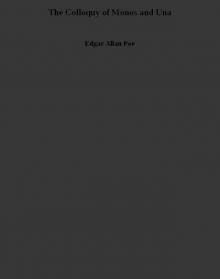 The Colloquy of Monos and Una
The Colloquy of Monos and Una The Oblong Box
The Oblong Box Thou Art the Man
Thou Art the Man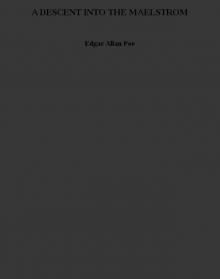 A DESCENT INTO THE MAELSTROM
A DESCENT INTO THE MAELSTROM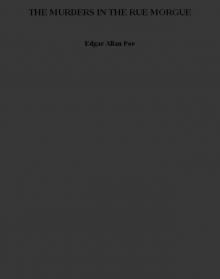 THE MURDERS IN THE RUE MORGUE
THE MURDERS IN THE RUE MORGUE The Business Man
The Business Man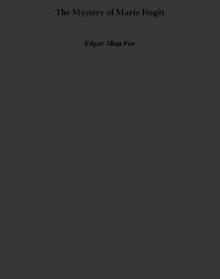 The Mystery of Marie Rogêt
The Mystery of Marie Rogêt Metzengerstein
Metzengerstein The Man That Was Used Up
The Man That Was Used Up William Wilson
William Wilson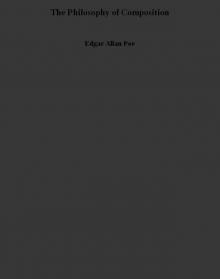 The Philosophy of Composition
The Philosophy of Composition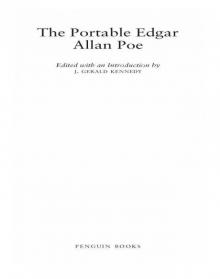 The Portable Edgar Allan Poe
The Portable Edgar Allan Poe Bon-Bon
Bon-Bon A Predicament
A Predicament The Premature Burial
The Premature Burial The Angel of the Odd
The Angel of the Odd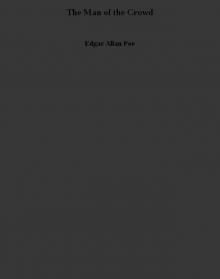 The Man of the Crowd
The Man of the Crowd Never Bet the Devil Your Head
Never Bet the Devil Your Head The Tell-Tale Heart and Other Writings
The Tell-Tale Heart and Other Writings The System of Doctor Tarr and Professor Fether
The System of Doctor Tarr and Professor Fether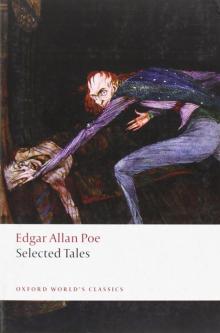 Selected Tales (Oxford World's Classics)
Selected Tales (Oxford World's Classics) Essential Tales and Poems of Edgar Allan Poe (Barnes & Noble Classics Series)
Essential Tales and Poems of Edgar Allan Poe (Barnes & Noble Classics Series) MS. Found in a Bottle
MS. Found in a Bottle Some Words with a Mummy
Some Words with a Mummy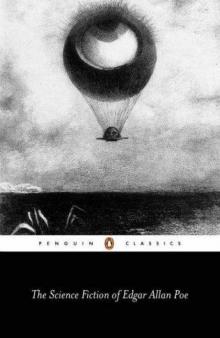 The Science Fiction of Edgar Allan Poe (Penguin Classics)
The Science Fiction of Edgar Allan Poe (Penguin Classics) King Pest
King Pest CRITICISM
CRITICISM How to Write a Blackwood Article
How to Write a Blackwood Article Mystification
Mystification Diddling Considered as One of the Exact Sciences
Diddling Considered as One of the Exact Sciences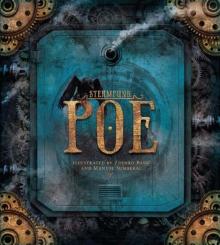 Steampunk Poe
Steampunk Poe The Literary Life of Thingum Bob, Esq.
The Literary Life of Thingum Bob, Esq.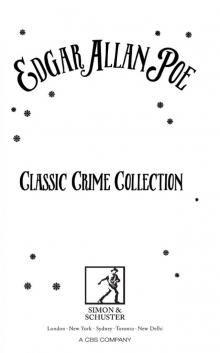 Classic Crime Collection
Classic Crime Collection Complete Stories and Poems of Edgar Allen Poe
Complete Stories and Poems of Edgar Allen Poe Berenice
Berenice The Black Cat
The Black Cat The Slender Poe Anthology
The Slender Poe Anthology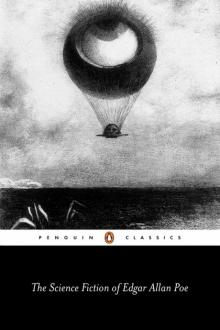 The Science Fiction of Edgar Allan Poe
The Science Fiction of Edgar Allan Poe The Assignation
The Assignation The Thousand-and-Second Tale of Scheherazade
The Thousand-and-Second Tale of Scheherazade The Raven and Other Short Stories
The Raven and Other Short Stories The Spectacles
The Spectacles Hop-Frog
Hop-Frog The Purloined Letter
The Purloined Letter Mellonta Tauta
Mellonta Tauta The Balloon-Hoax
The Balloon-Hoax Landor's Cottage
Landor's Cottage Mesmeric Revelation
Mesmeric Revelation The Pit and the Pendulum
The Pit and the Pendulum